April 3, 2009
The University of Illinois at Chicago (UIC) Forum to focus on How Cities can Lead the Way to a Global Economic Recovery
U.S. Vice President Joe Biden to Headline UIC's Fifth Annual Richard J. Daley Urban Forum.
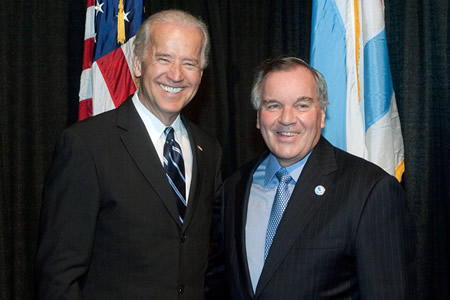
Photo: U.S. Vice President Joe Biden with Mayor Richard M. Daley at the Chicago Global Cities Forum. (City of Chicago, Antonio Dickey) [Photo Added: May 1, 2009]
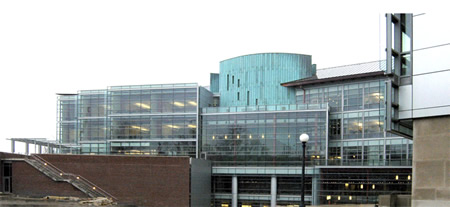
PHOTO: UNIVERSITY OF ILLINOIS COLLEGE OF ENGINEERING COMPUTER SCIENCE FACILITY
The University of Illinois at Chicago (UIC) and the Daley family will host the fifth annual Richard J. Daley Urban Forum, titled "Global Economic Recovery: Cities Lead the Way." U.S. Vice President Joe Biden will give the keynote address at this year's Forum, which will be held on Monday, April 27 beginning at 8:30 a.m. on the UIC campus.
The Forum will bring together municipal leaders from around the world, business leaders, public officials, policymakers, leading scholars and commentators for an intimate and interactive dialogue that examines the vital role cities will play in a successful recovery from today's global economic crisis.
Vice President Biden will be joined at the Forum by Chicago Mayor Richard M. Daley and a rich host of panelists providing diverse perspectives about how cities are crucial to recovery, what kinds of obstacles exist and the kinds of imaginative steps cities are already taking.
"We are thrilled and honored to have Vice President Biden join us for this year's Forum," said Mayor Daley. "President Obama and Vice President Biden understand the great role cities play in driving the larger economy. By working collaboratively, sharing innovative ideas and unleashing the entrepreneurial spirit and imagination, cities can lead our nation to a healthy and much needed economic recovery."
The Forum will feature three panels: "Economic Recovery and Urban Reinvestment," addressing the impact of national stimulus plans and regional and local initiatives on urban areas as well as key obstacles to these recovery efforts; "Economic Revitalization: Education and Healthcare," exploring how cities--as the center of innovation, creativity and entrepreneurship--can take the imaginative steps needed to climb out of today's world recession in a way that reaches far beyond urban areas; and a "Global Town Meeting" where mayors from more than 30 global cities will offer examples of innovative programs from their own cities in response to the global economic crisis. Panel formats are subject to change.
"The Forum has become a significant venue for the exchange of ideas and the exploration of strategies that address social and economic issues confronting urban communities in the United States and around the globe," said UIC Chancellor Paula Allen-Meares. "In 2008, for the first time in history, more than half of the world's people lived in urban areas. This global demographic change contributes to the urgency of the forum. Thus, UIC is proud to host this event."
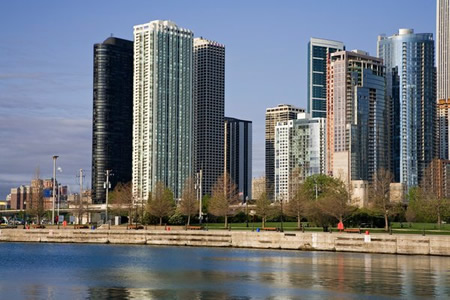
Photo: Chicago Skyscrapers seen from Navy Pier
The current economic crisis has imperiled both public and private finance and cost millions of citizens their jobs, homes and access to healthcare and education. While cities have been among the hardest hit economically, they also contribute the majority of the world's economic gross product and are responsible for most new job creation. Therefore, urban vitality is crucial to recovery.
Participants in this year's Forum include Marshall M. Bouton, President, The Chicago Council on Global Affairs; Victoria J. Chou, Dean, College of Education, University of Illinois at Chicago; Carol Coletta, President and Chief Executive Officer, CEOs for Cities; Richard M. Daley, Mayor, City of Chicago; Bruce Katz, Vice President, Brookings Institution; Michael H. Moskow, Former President, Federal Reserve Bank of Chicago and Senior Fellow, The Chicago Council on Global Affairs; Norbert Riedel, Corporate Vice President and Chief Scientific Officer, Baxter International, Inc. and Bernard Shaw, principal anchor emeritus, CNN.
The Urban Forum, held at the UIC Forum, 725 W. Roosevelt Rd., is open to the public. The registration fee will be waived for all UIC faculty, staff and students, as well as students from other universities. Students attending the Forum must present a valid college ID on the day of the event.
Cities expected to be represented at this year's forum include: Algiers, Algeria; Bangkok, Thailand; Beijing, China; Belgrade, Serbia; Bogota, Colombia; Busan, Republic of Korea; Cartagena, Colombia; Casablanca, Morocco; Chicago, USA; Doha, Qatar; Dubai, United Arab Emirates; Galway, Ireland; Glasgow, Scotland, United Kingdom; Hamburg, Germany; Helsinki, Finland; Jeddah, Saudi Arabia; Kuwait City, Kuwait; Kyiv, Ukraine; Lahore, Pakistan; Manila, The Philippines; Moscow, Russia; Nairobi, Kenya; Paris, France; Petach Tikva, Israel; Prague, Czech Republic; Reykjavik, Iceland; Riyadh, Saudi Arabia; Santo Domingo, Dominican Republic; Shenyang, China; Soriano, Uruguay; Tripoli, Lebanon; Vilnius, Lithuania and Windsor, Canada. Participating cities are subject to change.

Photo: Chicago Skyline
The 2009 Forum will be partially funded through sponsors including American Airlines, Ariel Investments, AT&T, Bank of America, Baxter, Blue Cross Blue Shield of Illinois, Boeing, The Chicago Community Trust, Chicago White Sox, DLA Piper, Exelon, Gibsons, Grosvenor Capital Management L.P., Katten Muchin Rosenman LLP, The MacArthur Foundation and the Patrick G. and Shirley W. Ryan Foundation.
Launched in 2005 to commemorate the 50th Anniversary of Richard J. Daley's first inauguration as Mayor of Chicago, the Richard J. Daley forum at UIC is an annual symposium for students, scholars, public officials, civic leaders, policymakers and commentators to discuss important issues and share insights into urban history and urban studies.
Richard J. Daley was first inaugurated as Mayor of Chicago on April 20, 1955. He served as Mayor for more than two decades, during which time he oversaw the rebirth of Chicago's downtown, construction of McCormick Place, development of O'Hare International Airport, and creation of UIC among other notable achievements.
Establishing UIC--originally known as the University of Illinois at Chicago Circle when it opened in 1965--was described by the late mayor as this greatest contribution to the life of the city. Circle Campus merged with the university's Medical Campus in 1982 to form UIC.
UIC is Chicago's largest university with more than 25,000 students, 12,000 faculty and staff, 15 colleges and the state's major public medical center. The campus ranks among the nation's top 50 universities in federal research funding. UIC has more than 145,000 alumni, more than 110,000 of whom live in the Chicago metropolitan area.
A hallmark of UIC is the Great Cities Commitment, through which faculty, students and staff engage with community, corporate, foundation and government partners in hundreds of programs to improve the quality of life in metropolitan areas around the world.
Source: The University of Illinois at Chicago
|GlobalGiants.com|







Edited & Posted by Editor | 12:34 PM | Link to this Post
April 2, 2009
Global Growth Rates Are In Positive Territory: The Conference Board

The Conference Board reports that global output growth in 2009 will be slow but remains positive at 1.3% for 2009. As the G-20 gathers in London, The Conference Board points at large discrepancies in the global economy this year, with advanced economies experiencing a strong contraction in output at -2.5% on average, and emerging economies pulling the world economy along at a reasonable pace of 5.0% on average.
"As projections of global growth have been slashed dramatically recently, we need to remain conscious of the huge uncertainties about how the decline in global trade affects the domestic sectors of emerging economies," says Bart van Ark, Vice President and Chief Economist of The Conference Board. "The internal dynamics of growth created by the millions of consumers in these countries, who have a job or are able to find a job, even in a slowing economy, will continue to generate positive growth." His analysis appears in StraightTalk, a newsletter designed exclusively for members of The Conference Board global business network.

MODEST RECOVERY IN THE U.S. REMAINS LIKELY
Real GDP in the United States is forecasted to fall by -5.9% on an annual rate during the first quarter of 2009, signaling a deep point in the recession. Some better numbers are beginning to emerge. The Conference Board Leading Economic Index and Consumer Confidence Index suggest that the recession will not intensify further. The decline in real consumer spending has leveled off a little. Retail sales, excluding cars and car parts, rose by .7% in February, and some turns in the measures of home sales and prices were also recorded. The Conference Board projects that growth in the second quarter will stay negative and will be very slow in the third quarter, as capital spending will remain low and inventories will not be depleted until year's end. Overall industrial production is also unlikely to move up before the fall. Even the recovery in the fourth quarter will be held back by these negative trends and increased unemployment, which is typically a lagging indicator.
The U.S. may see a contraction in real GDP of -2.6% in 2009 - the largest annual decline since 1946. Nominal output (the value of output that also reflects price change) may actually fall at more than 4%, as disinflation is much more likely in the short run than inflation.
RISK OF A "DOUBLE-DIP" RECESSION
Back-to-back recessions, as occurred between 1980 and 1982 when the economy endured a systemic crisis rather than a regular recessionary period, are a potential risk at this time. Recent increases in commodity prices, on the back of monetary easing and decline in the dollar, are leading to an increase in inflation expectations.
"If the United States experiences a too rapid recovery, there may be a risk of another recession in 2010," cautions Van Ark. "It may fuel expectations for a return to inflation, adding to the uncertainty concerning the pattern and path of economic recovery."
The likelihood of this happening is small as there are three substantial differences between the current crisis and that of the early 1980s: 1) Inflation was the concern then; now the possibility of deflation for the short and medium term is a greater threat. 2) The 1980s crisis was related to a structural transformation of the model of production in the U.S., moving from a manufacturing to a services economy; the current crisis was largely sparked by overleveraged balance sheets and global imbalances in consumption and savings. 3) This time we have massive governmental intervention intended to prevent economic activity from declining even further and stem the rise in unemployment.

LARGE DISCREPANCIES BETWEEN ADVANCED AND EMERGING ECONOMIES
The Conference Board argues that the divergence in growth performance between advanced and emerging economies will create a major challenge to rebalancing the world economy toward a more manageable global distribution of production, consumption and trade in goods and services.
The economies of commodity-producing countries - such as Russia and Brazil - have been producing bad results due to falling energy and commodity prices. China and India are the best bets to limit the global output collapse in 2009. China's export growth engine is under serious stress and the consumer sector will surely be affected by the decline in employment opportunities.
But the internal dynamics of growth created by the millions of consumers who still have a job or are able to find one in a slowing economy will continue to generate positive growth in China. Even though much of the U.S. $586 billion stimulus is likely to have already been baked into the government's investment plans, it may help keep China's growth rate at about 7.5% for 2009, says van Ark.
In India, as well as in several other large economies in the developing world that are somewhat less exposed to the global storm, the impact of the collapse in financial markets on fourth quarter GDP may have done a less lasting damage to the potential for growth this year.
Source: The Conference Board
|GlobalGiants.com|







Edited & Posted by Editor | 11:38 AM | Link to this Post
April 1, 2009
International Leaders Want All Nuclear Weapons Eliminated

With nuclear weapons high on the agenda for the historic first Obama-Medvedev meeting, more than 100 international leaders on the forefront of the Global Zero initiative are urging the U.S. and Russian presidents to work toward dramatic reductions of U.S. and Russian nuclear arsenals and then to lead a longer-term effort to eliminate nuclear weapons worldwide. These leaders said that because American and Russian stockpiles account for 96 percent of the world's nuclear weapons, the U.S. and Russia should begin with deep reductions to their arsenals, while beginning a dialogue with the other nuclear weapons states. The group believes that a commitment by nuclear powers to begin serious negotiations for global zero would strengthen the case against any non-nuclear nation which strives to acquire nuclear weapons and would set the stage for the first ever multilateral negotiation on nuclear reductions.

In addition to leaders from other key countries, the group is comprised of distinguished American and Russian leaders, including former U.S. Senator Chuck Hagel; Ambassador Richard Burt, former U.S. Chief Negotiator in Strategic Arms Reduction Talks; Gen. (Ret.) Jack Sheehan, Commander-in-Chief, U.S. Atlantic Command; former U.S. Secretary of State Lawrence Eagleburger; former U.S. Secretary of Defense Frank Carlucci; former U.S. National Security Advisor, Dr. Anthony Lake; former U.S. Ambassador to Russia Tom Pickering; former Russian Foreign Minister Igor Ivanov; former Soviet Union Foreign Minister Alexander Bessmertnykh; Col. Gen. (Ret.) Yevgeny Maslin, former Chief of the Main Directorate, Russian Ministry of Defense; Dr. Evgeny Velikhov, President, Kurchatov Institute; and Mr. Igor Yurgens, Chairman of the Institute of Contemporary Development (of which Russian President Medvedev is the Chairman of the Board of Trustees).
The Obama-Medvedev meeting is occuring in London on April 1, just before the kickoff of the G-20 meeting there.

Former U.S. Senator Chuck Hagel said this week, "We are urging the two presidents to seize this historic opportunity to confront the most urgent security threat to our world: the proliferation of nuclear weapons and the related risk of nuclear terrorism. The two leaders can move beyond traditional arms control and, in a bold move, set the world on a course toward the total elimination of all nuclear weapons -- global zero. This will not happen quickly, easily nor unilaterally. Getting to global zero will require the reduction of all nations' nuclear arsenals over many years. It is important to begin now, and set the world on a new course."
Former Russian Foreign Minister Igor Ivanov said, "A far-reaching joint initiative by Presidents Medvedev and Obama in favor of nuclear weapons non-proliferation and nuclear arms limitations brings the problem to the top of the contemporary international policy agenda. It would set the stage for multiplying efforts in the nuclear disarmament and arms limitations area at the bilateral, regional and global levels, for strengthening the nuclear weapons non-proliferation regime, and for a constructive outcome of the 2010 Non-Proliferation Treaty Review Conference. Constructive and long-term cooperation between Russia and the U.S., who possess more than 90 percent of the world's nuclear weapons, is crucial for nuclear non-proliferation and nuclear weapons reductions. However, that process should not be limited to Russian-American efforts. The other nuclear states should contribute to that as well. That kind of interaction predetermines success of international efforts for building up the international security of the 21 Century and moving toward the world free of nuclear weapons."
Global Zero is a new worldwide, nonpartisan initiative spearheaded by more than 100 international leaders working for a binding, verifiable agreement to eliminate all nuclear weapons. The group includes nine former heads of state; eight former foreign ministers from the United States, Russia, Britain and India; three former defense ministers from the United States and Britain; six former national security advisors from the United States, India and Pakistan; and nineteen former top military commanders from the United States, Russia, China, Britain, India and Pakistan. Global Zero is forming an international commission of prominent political and military leaders and policy experts from key countries that will be unveiled in the coming weeks. With a clear, realistic and pragmatic appreciation of the challenges of achieving the goal, this distinguished commission will develop a detailed step-by-step action plan for getting to zero nuclear weapons.
In early March, Sen. Hagel and Amb. Burt met with President Medvedev in Moscow, where eliminating nuclear weapons was discussed. Sen. Hagel and Amb. Burt have given letters to Presidents Obama and Medvedev, co-signed by more than 90 Global Zero leaders, urging bold action toward eliminating nuclear weapons.
Last July, then-candidate Barack Obama said, "It is time to ... stop the spread of nuclear weapons; and to reduce the arsenals from another era. This is the moment to begin the work of seeking the peace of a world without nuclear weapons." This month, President Medvedev declared that his country "... is fully committed to reaching the goal of a world free from these most deadly weapons."
Source: Global Zero
|GlobalGiants.com|
"I do not know with what weapons World War III will be fought, but World War IV will be fought with sticks and stones. "
-- Albert Einstein
"And he shall judge among the nations, and shall rebuke many people: and they shall beat their swords into plowshares, and their spears into pruninghooks: nation shall not lift up sword against nation, neither shall they learn war any more...
The wolf also shall dwell with the lamb, and the leopard shall lie down with the kid; and the calf and the young lion and the fatling together; and a little child shall lead them."
-- Isaiah 2:4, 11:6







Edited & Posted by Editor | 9:39 AM | Link to this Post
March 18, 2009
Reputation Risk Management Is on the Rise in U.S. and European Corporations -- The Conference Board
But Many Companies Still Have a Long Way to Go in Protecting Their Reputations.

According to a new report from The Conference Board (global business research and membership organization), a growing number of major global companies are investing substantial resources to manage their reputation risk and have increased their efforts to do so over the last three years.
"Safeguarding reputation is even more critical today because companies have developed successful ways to make reputation risk management part of their overall risk management," says Ellen Hexter, Director, Enterprise Risk Management at The Conference Board and co-author of the report with Sandy Bayer, President of Bayer Consulting. "In addition, different stakeholder groups are becoming more sophisticated in how they drive corporate reputations. Critics on the Internet can now transmit their opinions and complaints around the world with ease. Most importantly, consumers have high expectations that companies will not only produce quality products and services, but also will act ethically in their creation and distribution."
The report defines reputation as how a company is perceived by each of its stakeholder groups and reputation risk as the risk that an event will negatively influence stakeholder perceptions. Many reputation risks are the secondary result of other, more traditionally recognized risks. For example, if a manufacturer produces an unsafe product, it may lose customers and is likely to suffer financial costs due to a product recall, both of which impact reputation. Reputations may be damaged for any number of reasons, including that stakeholders perceive a company to be unethical.

"Although reputation is the quintessential intangible asset, a strong corporate reputation yields concrete benefits - higher market value, stronger sales, and an increased ability to hire the best and the brightest," says Bayer.
The report is based on the findings of The Conference Board Reputation Risk Research Working Group and a survey of 148 risk management executives of major corporations. More than three quarters of the respondents to the survey said their companies are making a substantial effort to manage reputation risk (82 percent) and they have increased focus in this area over the last three years (81 percent).
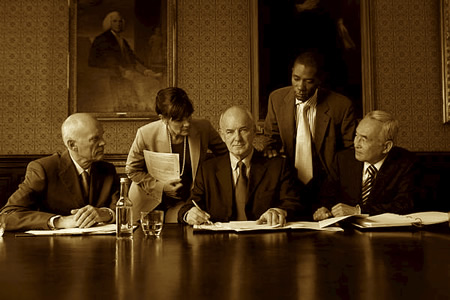
Other key findings of the study:
• Reputation risk should be managed throughout the organization. Although communication is of critical importance in responding to a risk event, a company's reputation should be considered during the preparation and execution of strategy and new projects, which hasn't been the case in most companies.
• Reputation risk is often not incorporated into risk management. Only 49 percent of executives surveyed said that the management of reputation risk was highly integrated with their Enterprise Risk Management (ERM) function or another risk oversight program.
• Assessing reputation risks is a top challenge. Fifty-nine percent indicated that assessing the perceptions and concerns of stakeholders was an extremely or very significant issue, making it the highest-ranked challenge.
• Media monitoring has become more sophisticated. Today, there are tools to assess whether coverage is positive, neutral or negative; the credibility of publications; the prominence of coverage, etc.
• Efforts are being made to quantify the value of reputation. A select group of companies is making progress in this area by working with specialist consulting firms to quantify the impact of reputation on share price.
• Social media are gaining influence, but most companies are ignoring them. Although consumers and investors are increasingly gathering information from blogs, online forums, and social networking sites, only 34 percent of the survey respondents said they extensively monitor such sites, and only 10 percent actively participated in them.

The findings spurred the following recommendations from The Conference Board Research Working Group:
1) Actively involve boards of directors in reputation risk management.
2) Demonstrate to leaders and management teams in business units the impact of their actions on reputation.
3) Integrate reputation risk management with ERM or other risk management programs.
4) Quantify the value of reputation.
5) Use and nurture employees as corporate ambassadors.
"Boards of directors, senior management, and operating management should demonstrate an active commitment to strong reputation management," conclude the authors.
Source: The Conference Board
|GlobalGiants.com|
"Our reputation is more important than the last hundred million dollars."
-- Rupert Murdoch
"From the sublime to the ridiculous there is but one step."
-- Napoleon Bonaparte







Edited & Posted by Editor | 12:59 AM | Link to this Post
January 30, 2009
Global Leaders Pledge Collaboration for Global Solutions to Global Crisis
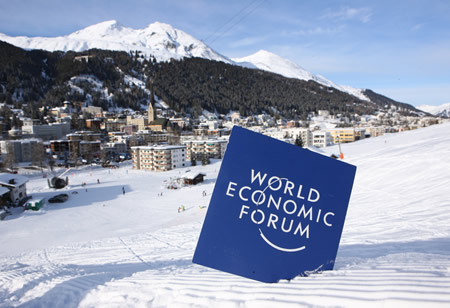
Photo: A sign with the logo of the World Economic Forum stands in the snow during preparations for the upcomming Annual Meeting 2009 of the World Economic Forum in Davos, Switzerland, January 26, 2009. (© World Economic Forum/Christof Sonderegger)

Photo: Impression of Davos: The biggest tourism resorts of the Swiss alps, captured before the opening of the Annual Meeting 2009 of the World Economic Forum in Davos, Switzerland, January 25, 2009. (© World Economic Forum/Christof Sonderegger)
Government, business and civil society leaders are at the World Economic Forum Annual Meeting 2009 at Davos, Switzerland, in record numbers to discuss ways out of the worst financial crisis in eight decades. "Davos fills the vital need for a global and dialogue-based platform where knowledgeable and empowered stakeholders can collaborate to address issues of common criticality. I can't think of a better time and a better reason to be at Davos," said Anand Mahindra, Vice-Chairman and Managing Director, Mahindra & Mahindra, India and Co-Chair of the Annual Meeting 2009.
"It is important that leaders who come here go back and work on ways of finding far-reaching policies that will allow us to create sustainable economic growth, create jobs and coordinate macroeconomic policies," insisted Kofi Annan, Secretary-General, United Nations (1997-2006), Member of the Foundation Board of the World Economic Forum and Co-Chair, Annual Meeting 2009, on the opening day of the five-day Annual Meeting.
"I believe we are also facing a crisis of governance at a national and international level. The current architecture of managing global affairs is broken and needs to be fixed. We have new players that have to be integrated and the poor have to be given a voice," he said. "The world has changed; are we capable of changing fast enough to save the planet?"
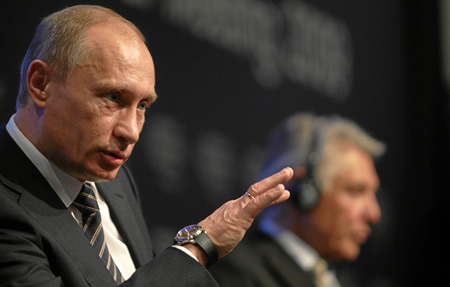
Photo: Vladimir Putin, Prime Minister of the Russian Federation talks to the participants of the 'Private Meeting of the Members of the International Business Council with Vladimir Putin' at the Annual Meeting 2009 of the World Economic Forum in Davos, Switzerland, January 29, 2009. (© World Economic Forum/Sebastian Derungs)
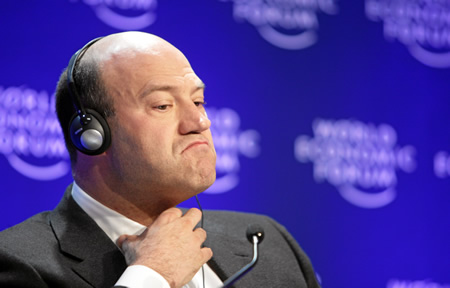
Photo: Gary D. Cohn, President and Co-Chief Operating Officer, Goldman Sachs, USA, captured during the session 'Managing Global Risks' at the Annual Meeting 2009 of the World Economic Forum in Davos, Switzerland, January 29, 2009. (© World Economic Forum/Sebastian Derungs)
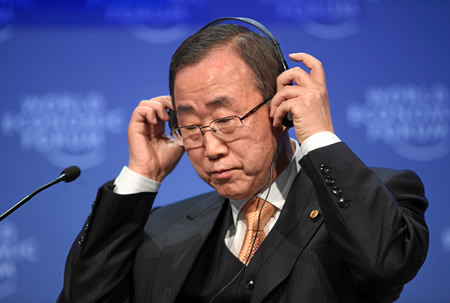
Photo: Ban Ki-moon, Secretary-General, United Nations, New York adjusts his headphones during the session 'Gaza: The Case for Middle East Peace' at the Annual Meeting 2009 of the World Economic Forum in Davos, Switzerland, January 29, 2009. (© World Economic Forum/Monika Flueckiger)
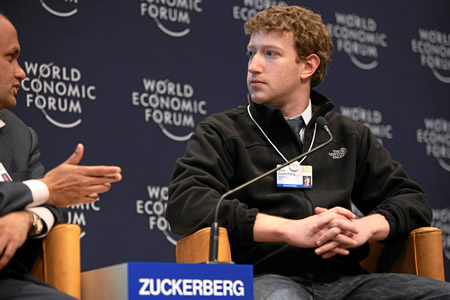
Photo: Mark Zuckerberg, Founder and Chief Executive Officer, Facebook, USA, captured during the session 'The Next Digital Experience' at the Annual Meeting 2009 of the World Economic Forum in Davos, Switzerland, January 30, 2009. (© World Economic Forum/Remy Steinegger)
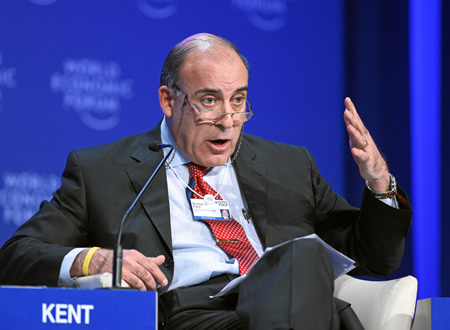
Photo: Muhtar A. Kent, President and Chief Executive Officer, The Coca-Cola Company, USA; Co-Chair of the Governors Meeting for Consumer Industries 2009, speaks during the session 'The Global Compact: Creating Sustainable Markets' at the Annual Meeting 2009 of the World Economic Forum in Davos, Switzerland, January 29, 2009. (© World Economic Forum/Christof Sonderegger)
Stephen Green, Group Chairman, HSBC Holdings, United Kingdom, and Co-Chair of the Annual Meeting 2009, agreed that the Annual Meeting gives leaders the space to share ideas needed to address current challenges. "Talking through what we need to do is important and that is why Davos is more than ordinarily important," he said.
The world is still in crisis, yet we should treat it "as an opportunity to set goals for how we want to come out of it, such as energy sufficiency, world pollution...and shape policies which will help to solve some of those problems," said Rupert Murdoch, Chairman and Chief Executive Officer, News Corporation, USA, and Co-Chair of the Annual Meeting 2009. "Don't let's lose sight of what creates wealth; it's open markets, capitalism and we've proved this again and again in last century," he cautioned.
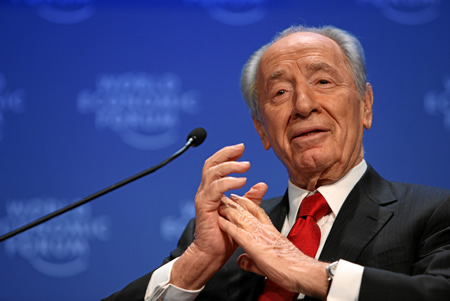
Photo: Shimon Peres, President of Israel, speaks during the session 'The Values behind Market Capitalism' at the Annual Meeting 2009 of the World Economic Forum in Davos, Switzerland, January 29, 2009. (© World Economic Forum/Remy Steinegger)
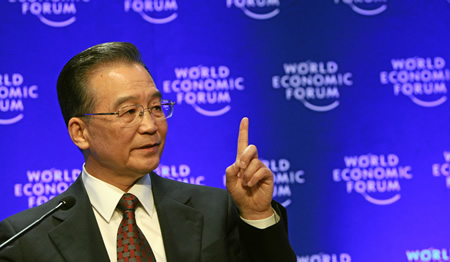
Photo: Wen Jiabao, Premier of the People's Republic of China is captured during a session at the Annual Meeting 2009 of the World Economic Forum in Davos, Switzerland, January 28, 2009. (© World Economic Forum/Christof Sonderegger)
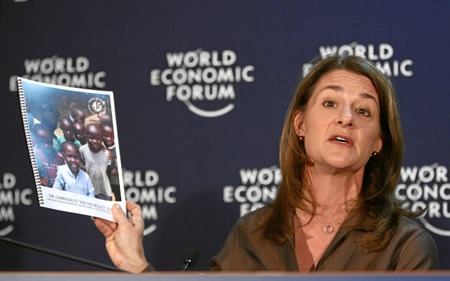
Photo: Melinda French Gates speaks during the 'Gates Foundation' press conference at the Annual Meeting 2009 of the World Economic Forum in Davos, Switzerland, January 30, 2009. (© World Economic Forum/Remy Steinegger)
"I do not expect we will find from Davos solutions, but expect that we are able to get a joint understanding of the reasons for the crisis, and that we get a good understanding of how we are really able to overcome such a severe crisis in a globalized world," said Werner Wenning, Chairman of the Board of Management, Bayer, Germany, and Co-Chair of the Annual Meeting 2009. "We're talking about growing populations; we have to address issues of how to secure energy supply and of climate change; we're also talking a lot about sustainability and returning to the basics of sustainable behavior."
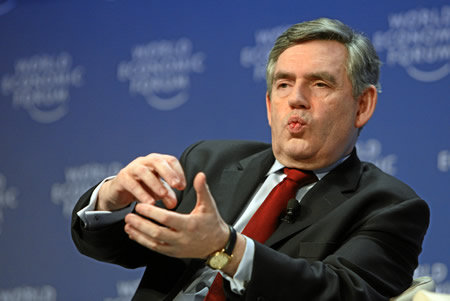
Photo: Gordon Brown, Prime Minister of the United Kingdom, speaks during the session 'A Conversation with' at the Annual Meeting 2009 of the World Economic Forum in Davos, Switzerland, January 31, 2009. (© World Economic Forum/Remy Steinegger)
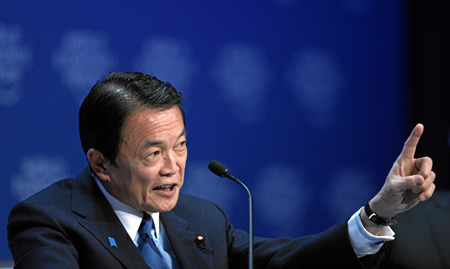
Photo: Taro Aso, Prime Minister of Japan, captured during the session 'Special Address by' at the Annual Meeting 2009 of the World Economic Forum in Davos, Switzerland, January 31, 2009. (© World Economic Forum/Sebastian Derungs)
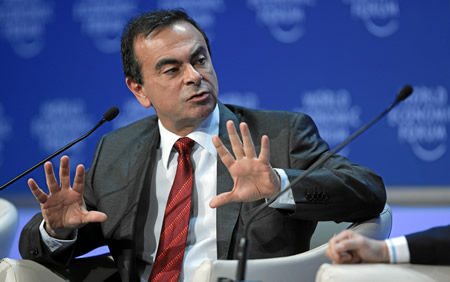
Photo: Carlos Ghosn, President and Chief Executive Officer, Renault, France; President and Chief Executive Officer, Nissan, Japan; Member of the Foundation Board of the World Economic Forum; Co-Chair of the Governors Meeting for the Automotive Industry 2009, captured during the session 'Special Address by Taro Aso' at the Annual Meeting 2009 of the World Economic Forum in Davos, Switzerland, January 31, 2009. (© World Economic Forum/Sebastian Derungs)
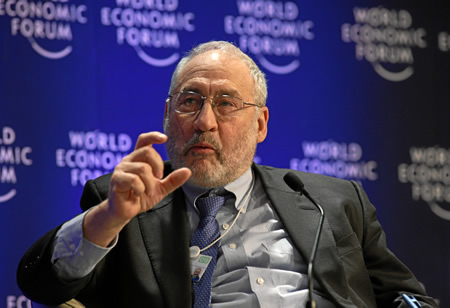
Photo: Joseph E. Stiglitz, Professor, Columbia University, USA, gestures during the session 'Rebooting the Global Economy' at the Annual Meeting 2009 of the World Economic Forum in Davos, Switzerland, January 31, 2009. (© World Economic Forum/Christof Sonderegger)
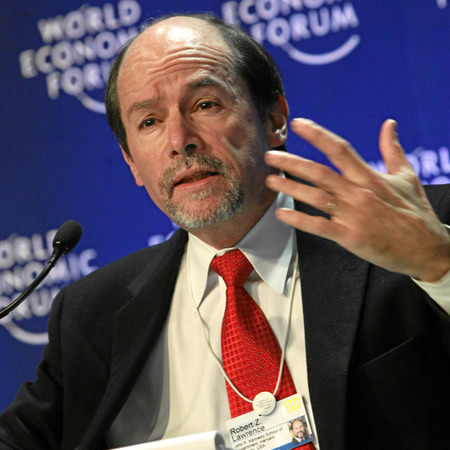
Photo: Robert Z. Lawrence, Albert L. Williams Professor of Trade and Investment, John F. Kennedy School of Government, Harvard University, USA; Chair, Global Agenda Council on Trade Facilitation, talks to the participants during the session 'The Fight against Protectionism' at the Annual Meeting 2009 of the World Economic Forum in Davos, Switzerland, January 31, 2009. (© World Economic Forum/Monika Flueckiger)
More than 2,500 participants from 96 countries are participating in the Annual Meeting held under the theme "Shaping the Post-Crisis World", including a record 40 heads of state or government. Key finance, foreign affairs, trade and energy ministers will join heads of non-governmental organizations, social entrepreneurs and religious leaders at the Meeting. Around 60% of the participants are business leaders drawn principally from the Forum's members - 1,000 of the foremost companies from around the world and across all economic sectors.
|GlobalGiants.com|
"Excessive accumulation of corrupt transactions (disguised as smart business) such as predatory, forcible or irrational lending via the agents whose sole objective is to pocket their commissions has landed us here.
It is NOT RECESSION, Gentlemen!
CORRECTION is taking place.
Analyze it technically and take authoritative actions to make it smooth and short."
© GlobalGiants.Com
"It is not by augmenting the capital of the country, but by rendering a greater part of that capital active and productive than would otherwise be so, that the most judicious operations of banking can increase the industry of the country."
-- Adam Smith







Edited & Posted by Editor | 5:27 AM | Link to this Post
November 16, 2008
Global Association of Risk Professionals Provides Financial Risk Manager Certification Exams to Nearly 14,000 Candidates Around the World
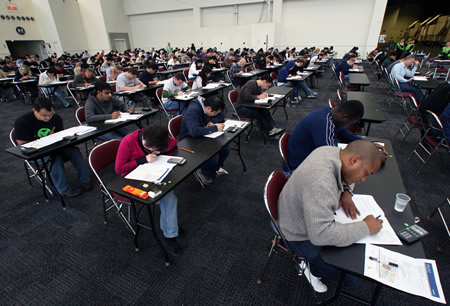
Photo: In New York's Jacob K. Javits Convention Center, November 15, several hundred financial risk manager certification candidates taking the 6-hour Financial Risk Manager (FRM(R)) Exam offered by the Global Association of Risk Professionals (GARP).
Yesterday, on November 15, at 9 am local time in each of 78 cities around the world, a record-breaking total 13,681 financial professionals were registered to take the annual Financial Risk Manager (FRM(R)) certification exam offered by the Global Association of Risk Professionals. From New York to Hong Kong, the 6-hour exams were taken at testing centers located in major cities across six continents including Mumbai, Beijing, Jakarta, Tokyo, Singapore, Seoul, Bangkok, London, Paris, Warsaw, Frankfurt, Istanbul, Dublin, Stockholm, Tel Aviv, Dubai, Melbourne, Sydney, Johannesburg, Montreal, Toronto, Dallas, Seattle, Honolulu and many others.
The Global Association of Risk Professionals (GARP) is a not-for-profit independent association of close to 100,000 risk management practitioners and researchers representing banks, investment management firms, government agencies, academic institutions, and corporations from more than 167 countries worldwide.
There were 500 candidates registered to take the exam in New York, 1,700 in Hong Kong and 1,100 in Mumbai, reflecting the significant and growing global attention to the practice of financial risk management," said Richard Apostolik, GARP President and CEO. "FRM certification has become the gold standard for financial risk managers to objectively demonstrate real world competence in their profession, and the FRM certification program is helping to expand industry-wide understanding of financial risk management best practices, concepts and theories," he added.
|GlobalGiants.com|







Edited & Posted by Editor | 2:40 AM | Link to this Post
October 4, 2008
Realtors, Accountants Applaud House Passage of Financial Stability Bill

"The National Association of Realtors(R) is truly relieved that members of the U.S. House of Representatives, like their counterparts in the Senate, were able to come together in a bipartisan effort to pass the Emergency Economic Stability Act of 2008. As we have been saying, this legislation is critical to stopping the economic turmoil that millions of Americans are facing. Today's action will go a long way toward ending the current economic crisis crippling the housing and financial markets.
This legislation would quickly restore liquidity to the mortgage market, which would stabilize the housing market and protect homeowners. Mortgages as well as personal and small business loans would become more available and less costly. Protecting Main Street not only benefits individuals, families and communities, but also supports the larger U.S. economy.
We expect that the president will act quickly to sign and enact this bill. We thank President Bush for his steadfast leadership on this issue, commend all parties that worked on this legislation, and look forward to working together toward a strengthened economy for the benefit of all Americans."
- Richard F. Gaylord, President, National Association of Realtors. [National Association of Realtors, 430 North Michigan Avenue, Chicago, IL 60611, USA.]

"The House of Representatives' historic vote demonstrated leadership in difficult times. Americans and businesses, small and large, are already suffering financial challenges as a result of this crisis. This legislation is the first step in restoring liquidity in our economy. CPAs will roll-up our sleeves to do our part to help individuals and businesses move forward. The profession has already been actively reaching out through extensive financial literacy efforts to help Americans cope with the personal financial challenges they face.
The AICPA is pleased Congress avoided calls by some for an immediate suspension of fair value accounting rules. The bill includes a call for an objective study of mark-to-market accounting. We look forward to participating with the Securities and Exchange Commission and the Financial Accounting Standards Board in a thoughtful review.
Accounting standards are the keystone of our financial reporting system and are designed to provide investors and management with timely signals about the financial condition of our publicly-traded companies. Our longstanding position is that accounting standards ultimately should be set by the private sector."
- Barry Melancon, President, American Institute of Certified Public Accountants (AICPA). [HQ: AICPA, 1211 Avenue of the Americas, New York, NY 10036, USA. The American Institute of Certified Public Accountants is the national, professional association of CPAs, with more than 350,000 CPA members in business and industry, public practice, government, education, student affiliates, and international associates. It sets ethical standards for the profession and U.S. auditing standards for audits of private companies, non-profit organizations, federal, state and local governments. It develops and grades the Uniform CPA Examination.]
|GlobalGiants.com|







Edited & Posted by Editor | 12:50 PM | Link to this Post
September 15, 2008
Barack Obama, John McCain Outline China Views
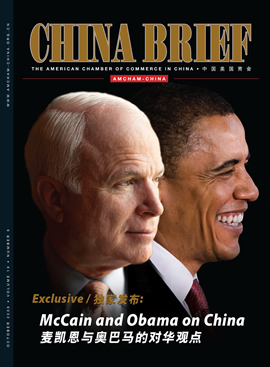
Photo: John McCain, Barack Obama Outline China Views Through AmCham-China.
The American Chamber of Commerce in China (AmCham-China) today announced in Beijing that US presidential candidates John McCain and Barack Obama have outlined their views on what US-China relations would be like under their respective administrations in articles written exclusively for AmCham. The articles, to be published in the October issue of AmCham-China's monthly magazine, China Brief, are believed to represent the first time the two candidates have publicly offered substantive details about their proposed China policies.
AmCham-China is a Beijing-based, non-profit organization representing the interests of some 2,700 companies and individuals doing business throughout China.
The articles outline the candidates' positions on a range of critical China-related business and policy issues facing the next US administration including trade balances, currency, security and the environment, as well as their thoughts on US competitiveness in the world economy.
"The fact that senators McCain and Obama chose to share their insights first with AmCham members is a testament to the chamber's reach and standing as an advocate for positive US-China business relations," said AmCham-China Chairman James Zimmerman. "We are encouraged to see both candidates call for further business development and more US engagement -- rather than isolationism -- in the years ahead. As a non-profit, non-partisan organization, AmCham-China looks forward to continuing good relations with the next administration."
Among many topics addressed, both candidates lay out clear indications of their views on trade.
For example, in his article Senator Obama writes that he will "undertake more sustained and serious efforts to combat intellectual property piracy in China, and to address regulations that discriminate against foreign investments in major sectors and other unfair trading practices." In addition, the senator pledges to work with China's leaders "to establish a better system for both countries to monitor products produced for export and act when dangerous products are identified."
Meanwhile, Senator McCain stresses China's obligations in improving bilateral trade relations. China's "commitment to open markets must include enforcement of international trade rules, protecting intellectual property, lowering manufacturing tariffs," he writes. "The next administration should be clear about where China needs to make progress, hold it to its commitments through enforcement at the World Trade Organization, and enforce US trade and product safety laws."
Source: The American Chamber of Commerce in China
|GlobalGiants.com|







Edited & Posted by Editor | 5:17 AM | Link to this Post
August 20, 2008
Branding at the Olympics

Photo: Cindy Crawford at the OMEGA Pavilion on the Olympic Green in Beijing on 14 August, 2008.
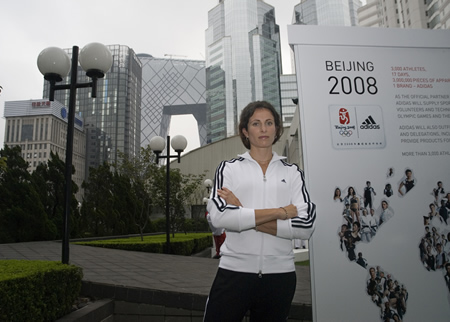
Photo: American pole-vault athlete Jennifer Stuczynski at adidas Brand Center in Beijing, China, August 11, 2008. At the center's Olympic Brand Launch Area, consumers can get close and personal with the special products, designs and technologies that adidas has developed for the Beijing 2008 Olympic Games.

Photo: Women's 200m Olympian Marshevet Hooker of the USA at adidas Brand Center in Beijing, China, August 15, 2008. The new adidas Brand Center showcases and highlights the breadth and depth of the adidas brand to the Chinese consumers as well as to all visitors of the Olympic Games.
As the Olympic Games unfold, the branding experts at Siegel+Gale are commenting on topics such as how the Olympics are affecting the "brand" of China, how companies are using the Olympics to further their brands, specific corporate ad campaigns, branding through sports events in general, and other strategic branding and positioning issues.

Following are some comments by Larry Vincent, Siegel+Gale's Group Director of Strategy in Los Angeles, and Julius Roberge, Siegel+Gale's Strategy Director in New York, most recently relocated from Shanghai:
Why Companies Align With the Olympics - Larry Vincent
• "Most companies align with the Olympics because they hope to borrow equity or transfer goodwill from that of the Olympics to their own brands."
• "Twenty years ago it was a slam dunk. McDonald's and Coca-Cola measured noticeable lifts in preference, favorability, and attitudes toward the brand during the co-brand window of the Games."
• "1984 was the turning point, however. The Los Angeles Games, in some ways, reinvented the sponsorship model (so much so that LA had a surplus of funds after the Games). It was so successful, that more brands wanted in."
• "Today, sponsors have changed quite a bit: there are more of them and the affiliation competes with branded partnerships in vastly more channels and platforms."
• "The Olympic equity is still strong (although research shows that it is the strongest when the Games are actually in progress), but it's harder to transfer or borrow the equity."
• "'False reporting' of 'unaided awareness' of Olympic sponsorships is on the rise (meaning, consumers attribute an Olympic sponsorship to the wrong company) and ambush tactics by other marketers are more prolific. In that context, you have to ask, 'What is the return on investment for a company that spends millions to sponsor the Games, and millions more to purchase the media that activates the sponsorship?'"

Photo: adidas Olympics advertising campaign: Together in 2008 - Impossible is Nothing.
• "It still works for some. We expect Adidas, Coca-Cola, and McDonald's will still do well. Part of that is the legacy. In Adidas' case, it's the innovative way they've gone to market."

"At the Beijing 2008 Olympics, American global giants are blindly following a crude and hazy sponsorship advertising policy. Consequently, their global brand equity enhancement is only a fraction of what they deserve for spending huge money on this pursuit.
While sponsoring the Beijing Games, their focus is on China. Excellent. But they, as well as America's top business commentators and writers, have put the rest of the world into oblivion. They seem to have no idea that without much further expenditure, these multinationals could have utilized this rare opportunity to firmly establish their brands throughout the world.
Localized print advertisements publicizing the company's privileged involvement in the 2008 Olympics, for example, would have won them universal goodwill and respect in all their target markets worldwide."
© GlobalGiants.Com
• "We do think the Olympics is a horrible place to debut new brands, however. There is too much clutter and competition."
• "It CAN be an effective place to reposition a brand, particularly if the brand is in the B2B space and the repositioning can occur onsite at the events. Many of the attendees of Olympic events are executives (just like the Super Bowl). UPS is using the Beijing Games as an interesting venue to debut some of their new international brand activity."
• "Intuitively, we should be seeing international companies getting more involved in the Games in the future. It can become the coming out event for large international companies who wish to elevate brand awareness on a global stage. But the challenge is that for many viewers, the brands will be so foreign they won't know who they are or what they do. It requires the brand to do a lot of seeding work before the Games begin, and very aggressive follow-up work once the brand has launched with the marks."
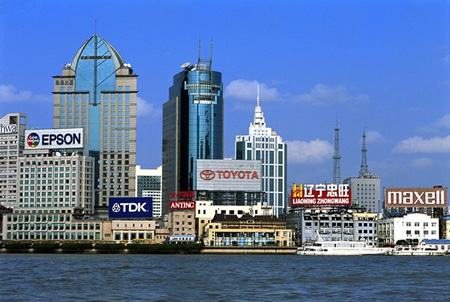

Photos: Shanghai, China.
The "China Brand" - Julius Roberge
• "Until China, never before has the market potential of the host country on its own been viewed as possibly worth the significant investment. Despite the degree of controversy before the Games began, the market opportunity seems irresistible."
• "The Olympics have a clear purpose for the "China" brand: to prove to the world that China is capable of hosting Games at a quality level that the Olympic brand, the athletes and spectators worldwide demand and expect."
• "The China brand today is often correlated with low quality (products), so the challenge is Herculean. With the world watching their every step, success in Beijing will send a strong new message about China as a world power. If it missteps, it will not soon have such visibility to transform a lagging image."
• "It's safe to assume Americans understand that Olympic sponsorship is not the same as supporting China's political policies. That said, given the ongoing buzz and interest in how China enters the world stage, how a brand behaves in and/or partners with China may draw more attention in the future from international media, thus elevating the potential for a negative effect on a brand's image. This may be more of a concern for B2B organizations that deal more closely with the Chinese government or in government monitored sectors."
Siegel+Gale is one of the world's premier strategic branding companies. The firm has worked with an array of leading organizations, including American Express, AARP, College Board, Cornell University, Dell, Duke University, Lexus, MBA.com, Merrill Lynch, Motorola, the National Basketball Association, 3M, Dow, and The Four Seasons Hotel Group, Sony, and Yahoo! Siegel+Gale has full-service offices in New York, Los Angeles, London, and Dubai and strategic partnerships around the world. Siegel+Gale is part of the Omnicom Group Inc., a leading global marketing and corporate communications company.
Source: Siegel+Gale
|GlobalGiants.com|







Edited & Posted by Editor | 2:02 AM | Link to this Post
August 18, 2008
adidas brand shines at Beijing 2008 Olympics


Photo: "adidas by Stella McCartney" Spring / Summer 08 Golf
Headquartered in Herzogenaurach, Germany, the adidas Group is one of the global leaders within the sporting goods industry and the adidas brand is one of the leading sports brands in the world. The brand attitude "Impossible is Nothing" drives all brand communication initiatives.
• As the Official Sportswear Partner of the Beijing 2008 Olympic Games, adidas has been outfitting more than 100,000 volunteers, technical officials and staff. adidas has also been providing products for more than 3,000 athletes, 214 federations and 16 National Olympic Committees. In total, adidas is providing more than 3 million pieces of products for the Olympic Games including 43 different athletic shoes for 27 out of 28 sports.
adidas will be the Official Sportswear Partner again for the London 2012 Olympic Games.
adidas's Beijing Olympics operation is an extraordinary piece of sponsorship advertising and is the elite launching pad from where it can successfully strike any country, region or sports market it wishes to target worldwide. ©GlobalGiants.Com

Photo: The adidas Brand Center in Beijing.
adidas has opened its largest adidas Brand Center worldwide in Beijing, China, the host city of the 2008 Olympic Games. This adidas Brand Center store is the biggest adidas store worldwide occupying four floors inside the new Sanlitun Village Shopping Center.
"The opening of the world's first adidas Brand Center is another milestone in securing market leadership in China, one of the world's most important markets for the adidas brand," said Erich Stamminger, President of the adidas brand. "The Beijing adidas Brand Center will serve as a role model for our concept stores in key metropolitan cities around the world."
One of the highlights of the new adidas Brand Center is miCoach Core Skills, an interactive zone where customers can utilize innovative adidas technologies that are normally only available in professional level sports facilities. Visitors to the store can test their skills in balance, speed and jump, compare their results to their sporting heroes and get personalized training recommendations based on scientific research, using a number of interactive devices.
The 'Urban' area on the top floor of the adidas Brand Center is a new creative space dedicated to exploring and showcasing exciting trends and ideas in art, music and culture. This area will play host to a series of events, including concerts, art exhibitions, and consumer forums and meetings.
At the center's Olympic Brand Launch Area, consumers can get close and personal with the special products, designs and technologies that adidas has developed for the Beijing 2008 Olympic Games.
View the "Made for Beijing" Footwear from adidas:
• Archery
• Boxing
• Cycling
• Discus
• Fencing
• Handball
• Hockey
• Javelin
• Rowing
• Sailing
• Shooting
• Tennis
|GlobalGiants.com|







Edited & Posted by Editor | 10:31 AM | Link to this Post
August 8, 2008
United States Postal Service Issues Most Popular Stamp Series of All Time -- The Art of Disney: Imagination
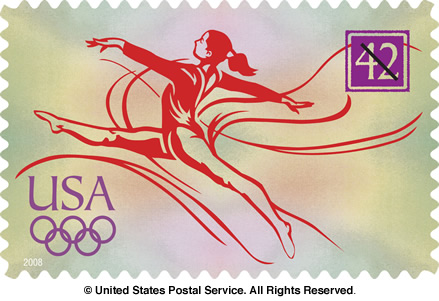
Photo: U.S. Postage Stamp on 2008 Olympic Games

Photo: The United States Postal Service delivers 212 billion pieces of mail to over 144 million homes, businesses and Post Office boxes every year. It handles more than 44% of the world's mail volume--delivering more mail to more addresses and to a larger geographic area than any other postal administration in the world.
Although Elvis remains king as the single most popular stamp subject of all time with an estimated 124.1 million collected, Mickey Mouse and his friends rule as the most popular stamp series with 211.5 million collected. Originally scheduled to be introduced as three sets during a three-year period, the fifth and final debut for the Art of Disney series took place Aug. 7 in front of the Sleeping Beauty castle in Disneyland when the Postal Service dedicated the Art of Disney: Imagination stamps. The 42-cent first-class commemorative stamps went on sale nationwide that day.
"The Art of Disney stamps have connected many Americans with friendship, celebration, romance, magic and now imagination through the mail," said U.S. Postal Service Chief of Staff Mike Spates, who joined Mickey and his friends in dedicating the stamps. "It's easy to add an imaginative touch to cards and letters with these beautiful stamps. We want to thank the many Disney characters for helping the Postal Service commemorate Walt Disney throughout the years."
Spates said 125 million Art of Disney: Imagination stamps were printed and are available in sheets of 20 and include four stamp designs:

• Mickey Mouse as Steamboat Willie. Walt Disney once said that Mickey was "created for the purposes of laughter." From the moment Walt Disney first imagined him, Mickey has been a happy reminder that a little laughter goes a long way; it's hard to imagine the world without his familiar smile.

• Princess Aurora (Sleeping Beauty) and her helpers Flora, Fauna, and Merryweather from Sleeping Beauty. Everyone dreams of living "happily ever after," but not everyone has such enchanting helpers as Princess Aurora's tiny guardians, Flora, Fauna, and Merryweather. Despite their delightfully dithery ways, the good fairies protect the princess and help her find the true love she has always imagined.

• Pongo and one of his pups from 101 Dalmatians. Imagining a dog's emotional life requires a brilliant creative leap, but 101 Dalmatians gives us a unique dog's eye view of the world. In the loving bonds between Pongo and his pups, we see our own human ties brought to life -- spot on.

• Mowgli and Baloo from The Jungle Book. Who could imagine a jungle as jazzy as in The Jungle Book -- or a more free-wheeling, upbeat buddy than Baloo? His lighthearted relationship with Mowgli reminds us that friendship and laughter really are among the "bare necessities of life. "
Spates added the series has proven to be popular with both stamp collectors and Disney enthusiasts.
"After the success of the first two Art of Disney sets with 47.7 million Friendship stamps collected in 2004 and 52.8 million Celebration stamps in 2005, we sat down with the Disney team to explore the possibility of extending the series. We feel the Art of Disney: Imagination stamps will finish the series as a cherished collectible."
The Postal Service randomly surveys approximately 10,000 customers four times annually to gauge the number of stamps collected. Spates said 57.2 million Romance stamps were collected in 2006 and 53.8 million Magic stamps in 2007.
The Disney relationship with the U.S. Postal Service began in the summer of 1918 when Walt Disney sorted and delivered mail in the Chicago Post Office. Next, Mickey Mouse worked for the Post Office when he starred in the 1933 animated short "Mail Pilot." The achievements of Walt Disney were first recognized on a stamp in 1968. On the stamp, a parade of children, hand-in-hand, appear from a tiny castle to surround a portrait of Walt Disney. The children, representing many nations of the world, are garbed in national costumes.
Source: U.S. Postal Service
|GlobalGiants.com|







Edited & Posted by Editor | 1:43 PM | Link to this Post
April 17, 2008
Thomson Reuters is Born: Unveils its New Branding and a Global Advertising Campaign
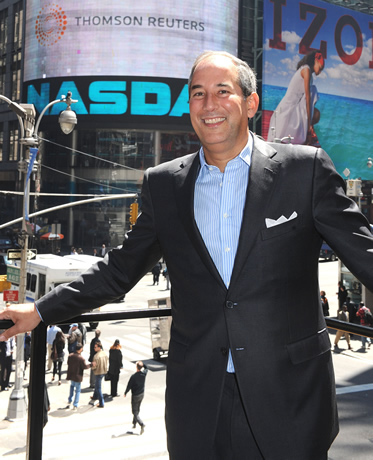
Photo: Thomas Glocer the new CEO of Thomson Reuters today unveiled its new branding and global advertising campaign across from multiple screens in Times Square, New York City. Mr. Glocer said, "The dynamic new corporate identity is a marked departure from the historical look and feel of the two companies and represents Thomson Reuters positioning as the world's leading source of intelligent information to businesses and professionals."
The Thomson Corporation has completed its acquisition of Reuters Group PLC, forming Thomson Reuters (NYSE: TRI; TSX: TRI; LSE: TRIL: NASDAQ: TRIN), the world's leading source of intelligent information for businesses and professionals in the financial, legal, tax and accounting, scientific, healthcare, and media markets.
At the same time, Thomson Reuters unveiled its new branding and a global advertising campaign. Mr. Thomas H. Glocer, chief executive officer of Thomson Reuters said, "The dynamic new corporate identity is a marked departure from the historical look and feel of the two companies and represents Thomson Reuters positioning as the world's leading source of intelligent information to businesses and professionals."
Thomson Reuters has more than 50,000 employees with operations in 93 countries on six continents and 2007 pro forma revenues of approximately US$12.4 billion.
Commenting on the just created Global Leadership Position of Thomson Reuters, Mr. Glocer said, "This is a very exciting day for our shareholders, customers and employees. Thomson Reuters will deliver the intelligent information needed to give businesses and professionals the knowledge to act. We call our information "intelligent" because it is not only insightful, highly relevant and timely, but it is also made available in formats which applications can consume and to which they can add further value. We are witnessing the maturation of the information economy and content from Thomson Reuters will be its currency." "Thomson Reuters will benefit from the value created by more diversified revenue streams, a larger capital base and synergies resulting from the acquisition. Our leadership position and global footprint will give us opportunities to grow faster than either Thomson or Reuters could have on its own," said Mr. Glocer.
On May 1, 2008, Thomson Reuters plans to announce results for the first quarter as well as a financial outlook for the remainder of 2008.
|GlobalGiants.com|







Edited & Posted by Editor | 11:04 AM | Link to this Post
March 29, 2008
SABEW 13th Annual Best in Business Journalism Contest Winners

![]()
Recognizing top publications and the best business news reporting during 2007, The Society of American Business Editors and Writers Inc. (SABEW), a not-for-profit organization made up of business journalists in North America, has announced the winners in its 13th annual Best in Business Contest. SABEW is headquartered at the Missouri School of Journalism at the University of Missouri-Columbia.
SABEW started the contest in 1995 to help set standards and recognize role models for outstanding business journalism. It has grown steadily since then. Categories for magazines and online sites were added this year. A record 842 entries were submitted for work in 2007 by daily newspapers, business weeklies, magazines, wire services and news Websites.
SABEW will hand out the awards during a ceremony at its annual conference, at 6 p.m. April 27 at The Sheraton Inner Harbor Hotel in Baltimore, Maryland.
Following is the full list of winners:
Overall Excellence
Giant Newspapers
(Average daily circulation above 325,000)
Arizona Republic
Los Angeles Times
The New York Times
USA Today
Certificates of Merit:
The Boston Globe
The Plain Dealer (Cleveland)
Large Newspapers
(circulation from 225,000 to 325,000)
The Miami Herald
Rocky Mountain News (Denver)
The Seattle Times
Certificates of Merit:
The Indianapolis Star
The Orange County Register
Detroit Free Press
Mid-sized Newspapers
(circulation from 125,000 to 224,999)
The Charlotte Observer
The Des Moines Register
The Detroit News
Grand RapidsPress
Seattle Post-Intelligencer
Certificates of Merit:
St. Paul Pioneer-Press
Salt Lake Tribune
Small newspapers
(circulation under 125,000)
Arizona Daily Star (Tucson, Ariz.)
The News Tribune (Tacoma, Wash.)
The Press Democrat (Santa Rosa, Calif.)
Certificates of Merit:
The Patriot Ledger (Quincy, Mass.)
The Post & Courier (Charleston, S.C.)
Weekly Business Newspapers
Advertising Age
Boston Business Journal
Crain's New York Business
Financial Week
Triangle Business Journal (Raleigh-Durham, N.C.)
Certificate of Merit:
Mass High Tech
Small Magazines
(circulation under 500,000)
Bloomberg Markets
Large Magazines
(circulation 500,000 and over)
Fast Company
Small Websites
(up to 500,000 average monthly unique visitors)
Wired.com
Certificate of Merit
Crain's Chicago Business
Mid-sized Websites
(500,000-2.5 million average monthly unique visitors)
AdAge.com
Certificate of Merit
Azstarbiz.com, Arizona Daily Star
Large Websites
(more than 2.5 million average monthly unique visitors)
MarketWatch
The New York Times Dealbook
The Wall Street Journal Online
Business News Reporting
Breaking News
Giant publications
• Patti Bond, Robert Luke, Tom Walker, Maria Saporta, Matt Kempner,
Marilyn Geewax, Duane D. Stanford, The Atlanta Journal-Constitution:
"Nardelli's departure from Home Depot"
• Krishna Guha, Michael Mackenzie, Saskia Scholtes and Gillian Tett, The
Financial Times: "Federal Reserve"
• Robin Sidel, Aaron Lucchetti, Monica Langley, Carrick Mollenkamp, David
Reilly and David Enrich, The Wall Street Journal: "The fall of a
Citigroup Prince"
Large publications
• Staff, Detroit Free Press: GM/UAW settlement
• Staff, Detroit Free Press: Pfizer breaking news
• Roger Fillion, Chris Walsh, David Milstead, Charles Chamberlin,
Joyzelle Davis, Rob Reuteman and Jane Hoback, Rocky Mountain News:
Coors-Miller merger
Mid-sized Publications
• Stella M. Hopkins, Adam Bell, Gail Smith-Arrants, Sharif Durhams,
Christopher D. Kirkpatrick, Tommy Tomlinson, Kat Greene, Marion
Paynter, Mark Johnson and David Ingram, The Charlotte Observer: "Philip
Morris quits North Carolina"
• Amos Maki, Commercial Appeal (Memphis.): "Toyota's decision"
• Sharon Terlep, Bruce G. Hoffman, Eric Morath, Christine Tierney, Daniel
Howes, Louis Aguilar, Nathan Hurst, Brian J. O'Connor, Josee Valcourt
and Bill Vlasic, The Detroit News: "UAW strike"
Small Publications
• Jack Gillum, Christie Smythe and David Wichner, Arizona Daily Star:
"First Magnus meltdown"
• Kathy Jumper, George Talbot, Russ Henderson, Sebastion Kitchen, Dan
Murtaugh, Kaija Wilkinson and Jeff Amy, Press-Register (Mobile, Ala.):
"Towering triumphs"
• Carol Benfell, The Press Democrat (Santa Rosa, Calif.): "Hospital
closure"
Weekly Publications
• Brent Snavely, Crain's Detroit Business: "Icahn on Lear: company
positioned well in industry"
• Andrew Osterland, Marine Cole, Matthew Quinn, Nicholas Rummell and
Frank Byrt, Financial Week: "Credit crunch"
Real-time News Organizations
• Scott Lanman, Brendan Murray, Matthew Brockett, Caroline Salas, Anthony
Massucci, Lynn Thomasson and Shannon Harrington, Bloomberg News:
"Bernanke's world unravels"
• John D. Stoll and Stephen Wisnefski, Dow Jones News Service:
"DaimlerChrysler stock moves into high gear"
Enterprise
Giant Publications
• David Barboza, The New York Times: "A Chinese reformer betrays his
cause, and pays"
• Gretchen Morgenson, The New York Times: "Crisis looms in mortgages"
• Kate Kelly, The Wall Street Journal: "Bear CEO's handling of crisis
raises issues"
Large Publications
• Jeffrey Tomich, St. Louis Post-Dispatch: "Bet the farm"
• Pete Carey, San Jose Mercury News: "Harsh side of the boom"
• Kristi Heim, The Seattle Times: "China's eco-city"
Mid-sized Publications
• Rick Rothacker and David Ingram, The Charlotte Observer: "Is this a
conflict?"
• Sharon Terlep and Bill Vlasic, The Detroit News: "Inside story"
• Rebecca Mowbray, New Orleans Times-Picayune: "Same house. Same repairs.
Same insurer. Why different prices?"
Small Publications
• Becky Pallack, Arizona Daily Star: "First Magnus: Boom to bust in three
weeks"
• Dan Kelley, Corpus Christi Caller-Times: "Is the city growing or
stretching?"
• George Talbot, Press-Register (Mobile, Ala.): "Several factors are key
to deal"
Weekly Publications
• Ron Leuty, San Francisco Business Times: "The fight of his life: Bay
Area tech execs and VCs rally to aid one of their own battling a rare
disease"
• Daniel Kaplan and Mark Mensheha, Street & Smith's SportBusiness
Journal: "American invasion: What's driving the gold rush to English
soccer?"
• Dan Monk and Tom Demeropolous, Business Courier of Cincinnati: "Dark
side of progress: The transformation of UC has taken more of a
financial toll than many in the campus community realize"
Real-time News Organizations
• John Schoen, MSNBC: "Mortgage mess"
• John Lippert, Bloomberg News: "Fall of Detroit"
• Melissa Davis, TheStreet.com: "Shattered hopes"
Columns
Giant Publications
• David Leonhardt, The New York Times
• Joseph Nocera, The New York Times
• Michelle Singletary, The Washington Post
Large Publications
• Eileen Ambrose, The Baltimore Sun
• Mary Jo Feldstein, St. Louis Post-Dispatch
• Al Lewis, The Denver Post
Mid-sized Publications
• Mitchell Schnurman, Fort Worth Star-Telegram
• George Gombossy, The Hartford Courant
• Liz Benston, Las Vegas Sun
Small Publications
• Gregory Karp, The Morning Call (Allentown, Pa.)
• Dan Voelpel, The News-Tribune (Tacoma, Wash.)
• Susan Miller, Ledger-Enquirer (Columbus, Ga.)
Weekly Publications
• Brian Kaberline, Kansas City Business Journal
• Greg David, Crain's New York Business
• Steve Symanovich, San Francisco Business Times
Real-time News Organizations
• Jon Markman, MSN Money
• James Saft, Reuters
• Brett Arends, TheStreet.com
Projects
Giant Publications
• Patricia Callahan, Maurice Possley, Michael Oneal, Evan Osnos, Ted
Gregory and Sam Roe, Chicago Tribune: "Hidden hazards"
• Charles Duhigg, The New York Times: "Golden opportunities"
• Walt Bogdanich, The New York Times: "Toxic pipeline"
Large Publications
• Suzanne Rust, Meg Kissinger and Cary Spivak, Milwaukee Journal
Sentinel: "Chemical fallout"
• Mike Casey and Rick Montgomery, Kansas City Star: "Fatal failures"
• Gargi Chakrabarty, Rocky Mountain News: "Ethanol boom: Kernel to car"
Mid-sized Publications
• Binyamin Appelbaum, Lisa Hammersly, Ted Mellnik, Peter St. Onge, Stella
M. Hopkins, Liz Chandler, Mike Drummond, Pam Kelley, Gary Schwab and
Patrick Scott, The Charlotte Observer: "Sold a nightmare"
• Lee Rood, Lynn Hicks, Philip Brasher, Paula Lavigne, Jerry Perkins,
Perry Beeman, Jon Benedict, Jeff Bruner, Suzanne Behnke and Don Tormey,
Des Moines Register: "Fueling Iowa's future"
• Christine Tierney and Bill Vlasic: The Detroit News: "Death of a
Merger"
Small Publications
• Winston Ross, The Register-Guard (Eugene, Ore.): "Big fish in a big
pond"
• Richard M. Hogan, Fort Myers (Fla.) News-Press: "Southwest Florida real
estate sellers beware"
• James L. Martin, Erie (Pa.) Times-News: "Made in Mexico"
Weekly Publications
• Bryant Ruiz Switzky, Katharine Grayson, Nancy Kuehn, Eric Johnson and
Dirk DeYoung, The Minneapolis- St. Paul Business Journal: "Operation
reintegration"
• Jeanne Lang Jones and Steve Wilhelm, Puget Sound Business Journal:
"Industrial land"
• Christopher Tritto, The St. Louis Business Journal: "Fig"
Real-time News Organizations
• David Dietz, Gary Cohn and Darrell Preston, Bloomberg News: "The
insurance hoax"
Magazine Cover Stories
Large Magazines
• Brian Grow and Keith Epstein, Business Week: "The poverty business"
• Ellen McGirt, Fast Company: "Al Gore's $100 million makeover"
Small Magazines
• David Evans, Richard Tomlinson, Seth Lubove and Daniel Taub, Bloomberg
Markets: "Toxic debt"
Online Excellence
Breaking News
Large Websites
• Tom Krazit, Caroline McCarthy, Erica Ogg, Kent German, Leslie Katz,
Brian Cooley, CNET News: "Launch of the iPhone"
• Staff, CNNMoney.com: "Turmoil in the mortgage and credit markets"
Small Websites
• Steve Daniels, Senior Reporter, Crain's Chicago Business: "LaSalle's
Richman near deal to join private bank"
• Alby Gallun, Reporter, Crain's Chicago Business: "Kennedy, developer
plan big Wolf Point project."
• Chad Eric Watt, Staff Writer; Dave Moore, Staff Writer, Dallas Business
Journal: "Questions dog press club"
Projects
Large Websites
• Rex Nutting, Amy Hoak and Alistair Barr, Marketwatch: "Subprime
shakedown: Will 'lemming loans' drive economy off cliff?"
• Art Lenehan, Anh Ly, Suzanne McGee and Chris Oster, MSN Money: "Keeping
up with the Wangs"
• David Barboza, Keith Bradsher, Howard French, Joseph Kahn, Jim Yardley
and the staff of The New York Times and nytimes.com: "Choking on
growth: China's environmental crisis"
Mid-sized Websites
• Ted Mellnik, Bill Pitzer, Phillip Hoffman, David Enna, The Charlotte
Observer: "Sold a nightmare"
Small Websites
Certificate of Merit
• Rich Laden, Nichole Montanez, Mark Reis, Christian Murdock, David
Bitton and Joanna Bean, The Gazette (Colorado Springs): "Academy
Boulevard at a crossroads"
Audio/Visual Reports
Large Websites
• John Authers, Financial Times: "Short view"
• Jenalia Moreno and Brett Coomer, Houston Chronicle: "Olive oil"
• David Pogue, The New York Times: "The iPhone challenge: keep it quiet"
Mid-sized Websites
• Hoag Levins, Ad Age: "3-Minute Ad Age"
• Stephanie AuWerter and Stacey Bradford, SmartMoney.com: "Smart Advice
video: avoiding foreclosure"
Blogs
Large Websites
• Dwight Silverman, Houston Chronicle: "Techblog"
• Staff, The New York Times: "Bits"
• Staff, The Wall Street Journal: "Deal Journal"
Mid-sized Websites
• Bill Bowen, Jim Fuquay, Dianna Hunt, Mike Lee, Richard Stubbe and Scott
Nishimura, Fort Worth Star-Telegram: "Barnett Shale: Drilling for
answers about the natural gas boom in North Texas"
• Jonathan Lansner, Orange County Register: "Lansner on real estate"
• Todd Bishop, Seattle Post-Intelligencer: "Todd Bishop's Microsoft Blog"
Creative Use of Online
Large Websites
• Roben Farzad, Business Week: Narrated slideshows
• Staff, MarketWatch: "The heat is on"
• Staff, CNNMoney.com: "2007 best places to live"
Student Contest
For stories written for professional publications
• Daniel Johnson, Seattle Times: "Grape-growing town not on wine lovers'
map"
For stories written for student publications
• Jessica Nunez, Columbia Missourian: "Funding farming"
Source: The Society of American Business Editors and Writers
|GlobalGiants.com|







Edited & Posted by Editor | 3:01 PM | Link to this Post
America's Best Graduate Schools: U.S.News & World Report Announces the Publication of the 2009 Edition

U.S.News & World Report today announced the publication of the 2009 edition of America's Best Graduate Schools. Examining more graduate programs than before, this year's edition of America's Best Graduate Schools is a comprehensive guide to graduate schools across the USA. The guide contains the exclusive rankings of over 1,500 graduate school programs in categories such as business, education, engineering, law, and medicine.

Following are the listings of the top 10 schools in each of the main disciplines.
2009 Graduate School Rankings
Schools of Business
1. Harvard University (MA)
Stanford University (CA)
3. University of Pennsylvania (Wharton)
4. Massachusetts Institute of Technology (Sloan)
Northwestern University (Kellogg) (IL)
University of Chicago
7. Dartmouth College (Tuck) (NH)
University of California-Berkeley (Haas)
9. Columbia University (NY)
10. New York University (Stern)
Schools of Education
1. Stanford University (CA)
2. Vanderbilt University (Peabody) (TN)
3. University of California-Los Angeles
4. Teachers College, Columbia University (NY)
5. University of Oregon
6. Harvard University (MA)
7. University of California-Berkeley
University of Washington
9. University of Michigan-Ann Arbor
10. University of Pennsylvania
University of Texas-Austin
Schools of Engineering
1. Massachusetts Institute of Technology
2. Stanford University (CA)
3. University of California-Berkeley
4. Georgia Institute of Technology
5. University of Illinois-Urbana-Champaign
6. California Institute of Technology
7. Carnegie Mellon University (PA)
8. University of Southern California (Viterbi)
9. Cornell University (NY)
University of Michigan-Ann Arbor
Schools of Law
1. Yale University (CT)
2. Harvard University (MA)
Stanford University (CA)
4. Columbia University (NY)
5. New York University
6. University of California-Berkeley
7. University of Chicago
University of Pennsylvania
9. Northwestern University (IL)
University of Michigan-Ann Arbor
University of Virginia
Schools of Medicine (Research)
1. Harvard University (MA)
2. Johns Hopkins University (MD)
3. Washington University in St. Louis
4. University of Pennsylvania
5. University of California-San Francisco
6. Duke University (NC)
University of Washington
8. Stanford University (CA)
9. University of California-Los Angeles (Geffen)
Yale University (CT)
Source: U.S.News & World Report
|GlobalGiants.com|







Edited & Posted by Editor | 6:20 AM | Link to this Post
March 19, 2008
Dick Colliver Receives Prestigious J.D. Power and Associates 'Founder's Award' for Distinguished Service in the Automotive Industry
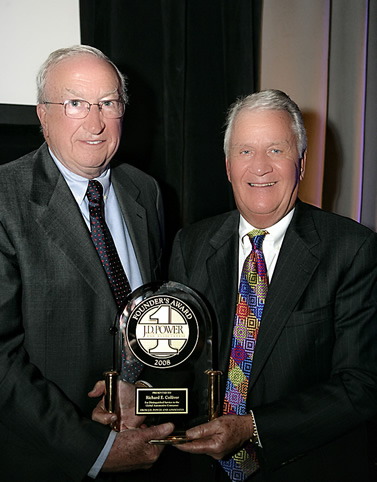
Photo: J.D. "Dave" Power III, founder of J.D. Power and Associates (left), presents the Founder's Award to Dick Colliver. The award was presented at the 2008 Wall Street Automotive Awards Dinner Tuesday evening at The Plaza Hotel in New York City on Tuesday, March 18.
J.D. Power III, founder of J.D. Power and Associates, presented the prestigious Founder's Award to Dick Colliver of American Honda Motor Co., Inc. for his outstanding commitment to customer service in the automotive industry.
Power presented the Founder's Award to Colliver, executive vice president of American Honda Motor Co., during the Wall Street Automotive Awards Dinner held at the Plaza Hotel in New York City on Tuesday, March 18.
A discretionary award presented periodically, the Founder's Award recognizes individuals or companies demonstrating dedication, commitment and sustained improvement in serving customers. In the 40-year history of J.D. Power and Associates, only 19 companies or individuals have previously received the award.

Photo: Honda Accord Coupe 2008
![]()
Honda is one of the world's leading producers of mobility products including its diverse line-up of automobiles, motorcycles and ATVs, power products, marine engines, personal watercraft, and aircraft. Founded in Japan in 1948, Honda began operations in the U.S. in 1959 with the establishment of American Honda Motor Co., Inc., Honda's first overseas subsidiary. The company has invested more than $9 billion in its North American operations with 14 major manufacturing facilities, employment of more than 35,000 associates, and annual purchases of more than $18 billion in parts and materials from suppliers in North America.
Colliver joined Honda as senior vice president of the Honda Automobile Division in 1993 and was promoted to executive vice president in July 1997. Prior to joining Honda, Colliver worked for more than 20 years with Mazda Motors of America. His automotive career, which began in 1962, included a variety of sales and marketing positions with General Motors and Chrysler.
Under Colliver's leadership, the Honda Automobile Division has set sales records each year, and Honda and Acura dealers are among the most profitable in the automotive industry.

Headquartered in Westlake Village, Calif., J.D. Power and Associates is a global marketing information services firm operating in key business sectors including market research, forecasting, performance improvement, training and customer satisfaction. The firm's quality and satisfaction measurements are based on responses from millions of consumers annually. J.D. Power and Associates is a business unit of The McGraw-Hill Companies. Founded in 1888, The McGraw-Hill Companies (NYSE:MHP) is a leading global information services provider meeting worldwide needs in the financial services, education and business information markets through leading brands such as Standard & Poor's, McGraw-Hill Education, BusinessWeek and J.D. Power and Associates. The Corporation has more than 280 offices in 40 countries. |GlobalGiants.com|







Edited & Posted by Editor | 5:57 AM | Link to this Post
October 9, 2007
Carnegie Medals Honors World's Great Philanthropists : GlobalGiants.com
The Tata family of India, Eli Broad, Heinz and Mellon Families to receive the Carnegie Medal of Philanthropy.

PITTSBURGH, Oct. 9 -- Four of the world's greatest philanthropists will be honored at the Carnegie Medals of Philanthropy celebration at 2 p.m. on Wednesday, October 17 at the Carnegie Music Hall in Pittsburgh.
This year's honorees are the Heinz family, the Mellon family, Eli Broad and the Tata family. The medals, created to honor Andrew Carnegie's career as a philanthropist, are awarded every two years to families and individuals who have dedicated their private wealth to the public good and who have sustained impressive careers as philanthropists.

Photo: Contemplating Philanthropy
The master of ceremonies for the event will be former NBC News anchor Tom Brokaw. Other notable presenters include Dr. A.P.J. Abdul Kalam, the former president of India; David Baltimore, a Nobel laureate in medicine and former president of the California Institute of Technology; Earl Powell III, director of the National Gallery of Art; and Agnes Gund, a 2005 Carnegie Medalist and president emerita of The Museum of Modern Art.
"Andrew Carnegie was determined to use his private wealth imaginatively, constructively, and systematically to address the fundamental problems of mankind, rather than simply to assuage symptoms," said Vartan Gregorian, president of Carnegie Corporation of New York and chair of the executive selection committee.

Photo: Carnegie Hall in New York City -- one of the Carnegie Institutions. Picture shows David Bernard conducting The Park Avenue Chamber Symphony at Carnegie Hall.
Created with the idea of serving as the "Nobel Prize for Philanthropy," the Carnegie Medals program began in 2001. This year's honorees cover a wide range of philanthropic efforts, both on the national and international stage:
• Eli Broad is a renowned business leader who built two Fortune 500 companies from the ground up over a five-decade career in business. He is the founder of both SunAmerica Inc. and KB Home (formerly Kaufman and Broad Home Corporation). Today, he and his wife, Edythe, are devoted to
philanthropy as founders of The Broad Foundations. With assets of more than $2.25 billion, The Broad Foundations are focused on entrepreneurship for the public good in education, scientific and medical research, and the arts. In an unprecedented partnership with the Massachusetts Institute of Technology, Harvard University and the Whitehead Institute, the Broads gave $200 million to create the Eli and Edythe Broad Institute for biomedical research. In fostering public appreciation for contemporary art, The Broad Art Foundation is a lending library of more than 1,200 artworks that have been loaned to more than 400 museums and university galleries worldwide.
• India's Tata family gives away between eight and 14 percent of the net profits from its controlling company each year to myriad causes: science, medicine, social services, health, civil society and
governance, rural welfare, performing arts, education and the needs of children. The Tata family legacy stretches back to the 19th century, when Jamsetji N. Tata started the Indian Institute of Science in Bangalore. Tata family's philosophy of "constructive philanthropy" has become embedded in its businesses, and has played a role in changing the traditional concept of charity throughout India. The Tata family is considered one of the few philanthropic forces in India with the potential to facilitate collaborative action on the problems that threaten individual, local and national development.
• The Heinz family's sustained philanthropic giving has supported the environment, education, economic opportunity and the arts as well as efforts to enhance the lives of women and children. In 1995, the family made one of the largest grants ever to benefit the environment $20 million to establish the Washington, D.C.-based H. John Heinz III Center for Science, Economics and the Environment. The Center brings together representatives of business, government, the scientific community and environmental groups to collaborate on the development of fair, scientifically sound environmental policies. Teresa Heinz will accept the award on behalf of the family.
• The Mellon family's impact on philanthropic giving began with Andrew Mellon's donation in the 1930s of his extensive art collection to provide the beginnings of the National Gallery of Art in Washington, D.C. as well as the Smithsonian's National Portrait Gallery. In 1969, Andrew's children Paul and Ailsa established the Andrew W. Mellon Foundation, which supports museums and art conservation, as well as higher education and scholarship, information technology research, performing arts and conservation, and the environment. In Pittsburgh, the family helped to create and continues to support Carnegie Mellon University.
This year's event is sponsored by UPMC and United States Steel Corporation. The Carnegie Institutions from around the world are Carnegie Corporation of New York (U.S.), Carnegies Belonningsfound for Heltemond (Denmark), Fondazione Carnegie (Italy), Foundation Carnegie (France), Carnegie Mellon University (U.S.), Carnegie Hall (U.S.), Carnegie Museums of Pittsburgh (U.S.), Fondation Carnegie pour les Sauveteurs (Switzerland), Carnegie Hero Fund Commission (U.S.), Carnegie Endowment for International Peace (U.S.), Carnegie United Kingdom Trust (U.K.), Carnegie Institution of Washington (U.S.), Carnegie Trust for the Universities of Scotland (U.K.), Carnegie Library of Pittsburgh (U.S.), Carnegie Council on Ethics and International Affairs (U.S.), Carnegie Heltefond for Norge (Norway), Carnegie Dunfermline Trust (U.K.), Carnegie Hero Fund Trust (U.K.), Carnegie Foundation for the Advancement of Teaching (U.S.), Carnegiestiflesen (Sweden), Carnegie Heldenfonds (Netherlands), Fondation Carnegie (Belgium) and Carnegie Stiftung fuer Lebensretter (Germany). |GlobalGiants.com|







Edited & Posted by Editor | 5:37 AM | Link to this Post
October 4, 2007
WORLD WILDLIFE FUND: GLOBAL CLIMATE CHANGE INITIATIVE

Sixteen celebrities have signed World Wildlife Fund "Hotter than I Should Be" t-shirts to be auctioned off on eBay starting today with funds going to support WWF's global climate change and other conservation initiatives. T-shirts have been signed by Kevin Bacon, Candice Bergen, Cate Blanchett, Orlando Bloom, Gisele Bundchen, Cindy Crawford, Harrison Ford, Scarlett Johansson, Tobey Maguire, Paul Newman, Rachael Ray, Susan Sarandon, Charlie Sheen, Martin Short, Oliver Stone and Betty White.

The WWF "Hotter than I Should Be" t-shirts are made of 100 percent organic cotton and are available for a donation of $50 or more. The t-shirts are part of WWF's campaign to raise awareness about the causes and impacts of climate change. WWF is working to stop climate change by providing cutting-edge science, championing policies to reduce carbon emissions and mobilizing businesses to drive new and innovative solutions. With a team of dedicated experts working in more than 50 countries, WWF is focused on four areas where it can have the most impact: creating responsible global warming policies; working with businesses to reduce carbon dioxide emissions; implementing adaptation plans to help the planet respond to the effects of climate change; and protecting forests that help mitigate climate change.
The largest multinational conservation organization in the world, WWF works in 100 countries and is supported by 1.2 million members in the United States and close to 5 million globally. |GlobalGiants.com|







Edited & Posted by Editor | 5:07 AM | Link to this Post
September 23, 2007
World's Major Economies Have High-Tax Handicap: C.D. Howe Institute

TORONTO, September 23, 2007 -- Many of the world's largest economies have a common malady handicapping their abilities to generate jobs and government revenues, according to an e-brief released by C.D. Howe Institute. From the United States, Germany and Japan, to other engines of the global economy, they tend to have high corporate income tax rates that blunt their competitiveness, making it harder for manufacturing and service businesses to adopt better technologies that would boost workers' incomes. Except for the United Kingdom, which is committed to reducing its corporate tax rate to 28 percent in 2008, most of the world's major economies rely on corporate rates in excess of 30 percent. These high rates hurt competitiveness, because when investment moves to low-tax jurisdictions, prospects worsen for economic growth and job creation. These high tax rates also hurt government revenues, say the authors, Duanjie Chen, Jack Mintz and Andrey Tarasov.
"High rates also hurt government revenues. The evidence shows that lower corporate tax rates, on the other hand, may increase rather than reduce revenues, because governments gain revenue from an expanding tax base, as business investment and profits grow, and this helps offset the effect of a lower rate. In other words, governments shoot themselves in the foot when they set corporate income tax rates too high, hurting both competitiveness and revenues.
We find evidence, based on analysis of data for the years 2001 to 2005, that corporate income tax collections as a share of GDPwould be maximized at a corporate income tax rate of 28 percent (see Figure 1). In other words, reductions in high corporate income tax rates above 28 percent could increase rather than reduce tax revenues as business activity expands and the tax base broadens.
High tax burdens on investment hurt a given country's competitiveness, and also that of their trading partners. Large economies, like Canada, France, Germany, Japan and the United States in particular, need to reduce corporate rates, because they are far too high relative to the revenue-maximizing corporate rate. With the possibility of an economic slowdown resulting from a collapsing housing market in the United States, the harm imposed by the high effective tax rates in the largest economies is not just bad for them, but for the world economy as a whole. President Sarkozy of France, for example, has proposed a sharp reduction in the corporate rate, to 25 percent. Others, especially Japan and the United States, should follow suit..."
The C.D. Howe Institute is a national, nonpartisan, nonprofit organization that aims to improve Canadians' standard of living by fostering sound economic and social policy. |GlobalGiants.com|







Edited & Posted by Editor | 1:26 AM | Link to this Post
September 6, 2007
THE SCHOLAR SHIP: Oceangoing Academic Program for Multi-Cultural Student Body Departs Athens, Greece on a Global Voyage
More than 200 University Students from 35 Countries Form a Transnational Learning Community Onboard The Scholar Ship.
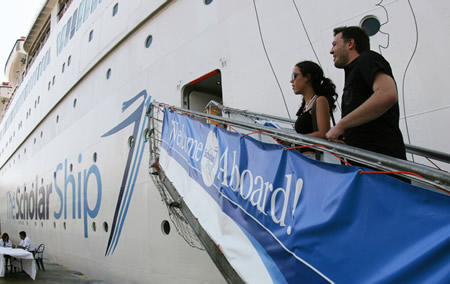
Photo: Two students embark The Scholar Ship in Piraeus,Greece, for the inaugural voyage of the oceangoing study abroad program -- the first developed for an international student body. The ship will travel to four continents over 16 weeks with more than 200 university students from 35 countries onboard.
The Scholar Ship, the first oceangoing study-abroad program developed specifically for an international student body, started its maiden voyage from Athens, Greece yesterday. More than 200 undergraduate and postgraduate students from 35 countries will travel to four continents over 16 weeks.
The Scholar Ship, backed by Royal Caribbean Cruises Ltd., and supported by seven international universities, will immerse students and faculty in an intercultural living and learning environment aboard a 201-meter ocean liner specially equipped for the academic program.
Students and staff are embarking on The Scholar Ship in Piraeus, Athens on a westward course to Lisbon, Portugal; Panama City, Panama; Guayaquil, Ecuador; Papeete, Tahiti; Auckland, New Zealand; Sydney, Australia; and Shanghai, Macau and Hong Kong in China. Ports of call provide extensive educational opportunities for students through a port program in which students participate in academic field study, community service and independent travel.
Seven international universities collaborated in the curricula development for The Scholar Ship, including the University of California, Berkeley and Macquarie University in Sydney, which has been designated to award academic credit to students. Other participating "Academic Stewards" include Fudan University, China; Tecnologico de Monterrey, Mexico; Cardiff University, United Kingdom; Al Akhawayn University, Morocco; and the University of Ghana.
Multinational corporations such as IBM, Microsoft and HSBC Bank also have been engaged to ensure that the program's learning outcomes are relevant and practical for students. The Scholar Ship's introduction reflects the increased interest in enriching study abroad programs worldwide. |GlobalGiants.com|







Edited & Posted by Editor | 2:05 AM | Link to this Post
September 4, 2007
THE PANAMA CANAL AUTHORITY STARTS THE EXPANSION OF THE PANAMA CANAL : GlobalGiants.com
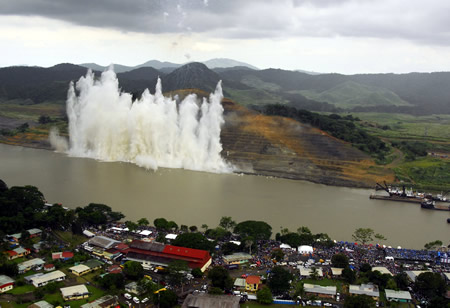
Photo: Panama City -- September 4, 2007 -- Thousands gathered in a ceremony near Paraiso Hill in Panama to celebrate the beginning of the first-ever expansion of the nearly 100-year-old Panama Canal. The symbolic blast inaugurated the first construction project for expansion. (Photo Credit: The Panama Canal Authority)
Joining former US President Carter at the event were regional presidents, including Colombia's Alvaro Uribe, Honduras' Manuel Zelaya, Nicaragua's Daniel Ortega and El Salvador's Elias Antonio Saca. Jose Miguel Inzulsa, secretary-general of the Organization of American States, also was among an estimated 40,000 people at the ceremony.
When complete, the expanded canal will accommodate ships capable of carrying 12,000 containers, up from a maximum 5,000 containers.
The Panama Canal (Spanish: Canal de Panamá) is a major ship canal that traverses the Isthmus of Panama in Central America, connecting the Atlantic and Pacific Oceans. Construction of the canal was one of the largest and most difficult engineering projects ever undertaken. A ship sailing from New York to San Francisco via the canal travels 9,500 km (6,000 miles), well under half the 22,500 km (14,000 mi) route around Cape Horn.
Since opening, the canal has been enormously successful, and continues to be a key conduit for international shipping. Each year more than 14,000 ships pass through the canal, carrying more than 205 million tons of cargo.
The Panama Canal Authority (ACP) is the autonomous agency of the Government of Panama in charge of managing, operating and maintaining the Panama Canal. |GlobalGiants.com|







Edited & Posted by Editor | 8:27 AM | Link to this Post












